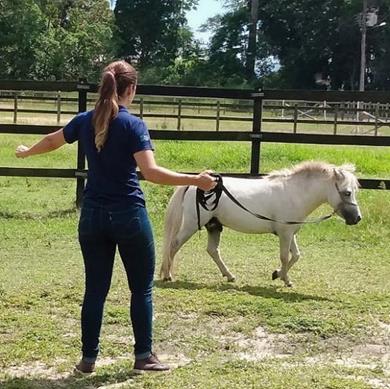Miniature horse training (Equus caballus) for use in equine assisted therapy, according to equine learning theory
DOI:
https://doi.org/10.21708/avb.2020.14.1.8932Abstract
Successful and safe Equine Assisted Therapy (EAT) relies on proper horse training. Two inexperienced trainers applied Equine Learning Theory on three miniature horses destined for use in EAT, under the supervision of an experienced horse trainer. This six-month program included the following tasks: halter placement (catch) and corporal contact acceptation (brush), limb suspension for hoof cleaning (hoof), halter leading (lead), step back (back off), whip acceptation as an extension of the trainers’ arm (whip move), corporal and verbal cues for circular movement (lunging), and inhibition of the undesired behavior of biting (don’t bite). At each training session, the horse was scored for each task, ranging from 0 (not able to perform) to 4 (ideal performance). Tasks taught exclusively based on negative reinforcement (lead, back off and whip move) responded well to training, while training of those behaviors taught by a combination of association with negative reinforcement (lunging) or with punishment (don’t bite) was not effective. Negative reinforcement alone was not enough to maintain the desired behavior once it was performed in hoof. No significative improvements were achieved on tasks that were already accepted by all (brush) or most (catch) of the animals.
Downloads

Downloads
Pubblicato
Fascicolo
Sezione
Licenza
Autores que publicam na Acta Veterinaria Brasilica concordam com os seguintes termos: a) Autores mantém os direitos autorais e concedem à revista o direito de primeira publicação, com o trabalho simultaneamente licenciado sob a Licença Creative Commons Attribution que permite o compartilhamento do trabalho com reconhecimento da autoria e publicação inicial nesta revista. b) Autores têm autorização para assumir contratos adicionais separadamente, para distribuição não-exclusiva da versão do trabalho publicada nesta revista (ex.: publicar em repositório institucional ou como capítulo de livro), com reconhecimento de autoria e publicação inicial nesta revista. c) Autores têm permissão e são estimulados a publicar e distribuir seu trabalho online (ex.: em repositórios institucionais ou na sua página pessoal) a qualquer ponto antes ou durante o processo editorial, já que isso pode gerar alterações produtivas, bem como aumentar o impacto e a citação do trabalho publicado (Veja O Efeito do Acesso Livre).


 Esta obra está licenciada com uma Licença
Esta obra está licenciada com uma Licença 